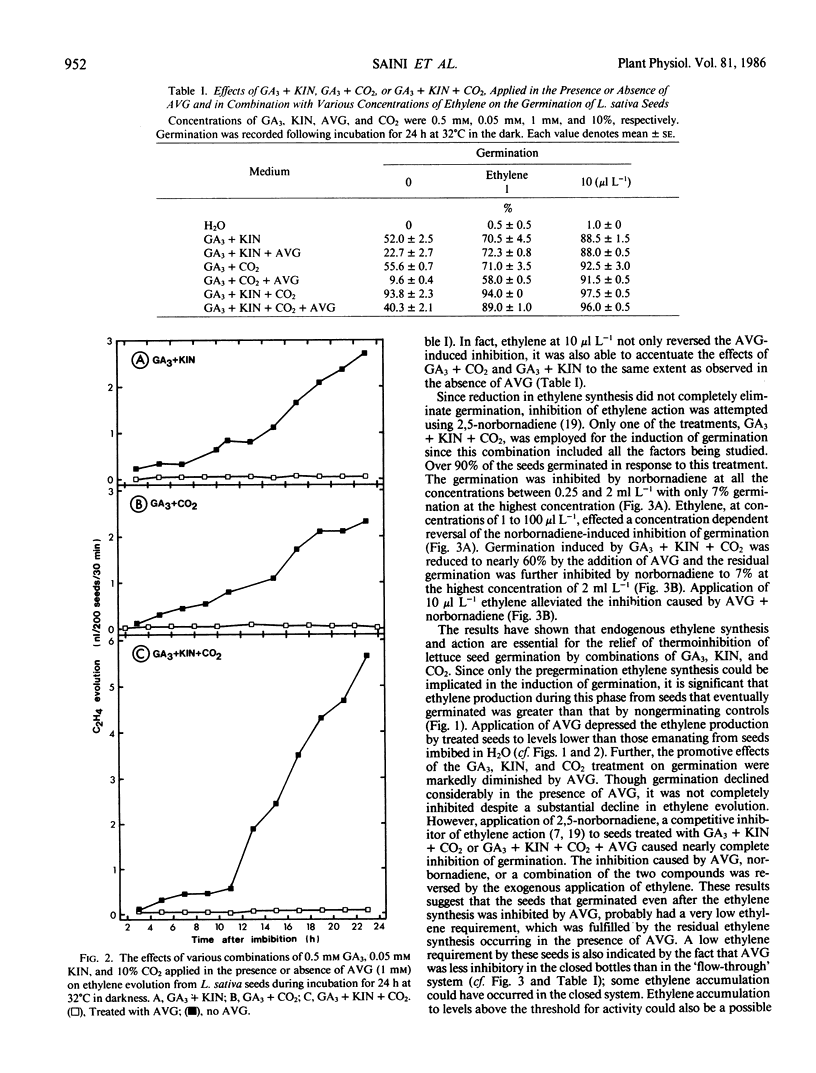Abstract
Application of exogenous ethylene in combination with gibberellic acid (GA3), kinetin (KIN), and/or CO2 has been reported to induce germination of lettuce seeds at supraoptimal temperatures. However, it is not clear whether endogenous ethylene also plays a mediatory role when germination under these conditions is induced by treatment regimes that do not include ethylene. Therefore, possible involvement of endogenous ethylene during the relief of thermoinhibition of lettuce (Lactuca sativa L. cv Grand Rapids) seed germination at 32°C was investigated. Combinations of GA3 (0.5 millimolar), KIN (0.05 millimolar), and CO2 (10%) were used to induce germination. Little germination occurred in controls or upon treatment with ethylene, KIN, or CO2. Neither KIN nor CO2 affected the rate of ethylene production by seeds. Both germination and ethylene production were slightly promoted by GA3. Treatments with GA3+CO2, GA3+KIN, or GA3+CO2+KIN resulted in approximately 10-to 40-fold increases in ethylene production and 50 to 100% promotion of germination as compared to controls. Initial ethylene evolution from the treated seeds was greater than from the controls and a major surge in ethylene evolution occurred at the time of visible germination. Application of 1 millimolar 2-aminoethoxyvinyl glycine (AVG), an inhibitor of ethylene synthesis, in combination with any of above three treatments inhibited the ethylene production to below control levels. This was accompanied by a marked decline in germination percentage. Germination was also inhibited by 2,5-norbornadiene (0.25-2 milliliters per liter), a competitive inhibitor of ethylene action. Application of exogenous ethylene (1-100 microliters per liter) overcame the inhibitory effects of AVG and 2,5-norbornadiene on germination. The results demonstrate that endogenous ethylene synthesis and action are essential for the alleviation of thermoinhibition of lettuce seeds by combinations of GA3, KIN, and CO2. It also appears that these treatment combinations do not act exclusively via promotion of ethylene evolution as the application of exogenous ethylene alone did not promote germination.
Full text
PDF



Selected References
These references are in PubMed. This may not be the complete list of references from this article.
- Abeles F. B., Lonski J. Stimulation of lettuce seed germination by ethylene. Plant Physiol. 1969 Feb;44(2):277–280. doi: 10.1104/pp.44.2.277. [DOI] [PMC free article] [PubMed] [Google Scholar]
- Burdett A. N. Antagonistic effects of high and low temperature pretreatments on the germination and pregermination ethylene synthesis of lettuce seeds. Plant Physiol. 1972 Aug;50(2):201–204. doi: 10.1104/pp.50.2.201. [DOI] [PMC free article] [PubMed] [Google Scholar]
- Eastwell K. C., Bassi P. K., Spencer M. E. Comparison and evaluation methods for the removal of ethylene and other hydrocarbons from air for biological studies. Plant Physiol. 1978 Nov;62(5):723–726. doi: 10.1104/pp.62.5.723. [DOI] [PMC free article] [PubMed] [Google Scholar]
- Ketring D. L., Morgan P. W. Physiology of Oil Seeds: IV. Role of Endogenous Ethylene and Inhibitory Regulators during Natural and Induced Afterripening of Dormant Virginia-type Peanut Seeds. Plant Physiol. 1972 Sep;50(3):382–387. doi: 10.1104/pp.50.3.382. [DOI] [PMC free article] [PubMed] [Google Scholar]
- Keys R. D., Smith O. E., Kumamoto J., Lyon J. L. Effect of Gibberellic Acid, Kinetin, and Ethylene plus Carbon Dioxide on the Thermodormancy of Lettuce Seed (Lactuca sativa L. cv. Mesa 659). Plant Physiol. 1975 Dec;56(6):826–829. doi: 10.1104/pp.56.6.826. [DOI] [PMC free article] [PubMed] [Google Scholar]
- Kristie D. N., Bassi P. K., Spencer M. S. Factors affecting the induction of secondary dormancy in lettuce. Plant Physiol. 1981 Jun;67(6):1224–1229. doi: 10.1104/pp.67.6.1224. [DOI] [PMC free article] [PubMed] [Google Scholar]
- Negm F. B., Smith O. E., Kumamoto J. Interaction of carbon dioxide and ethylene in overcoming thermodormancy of lettuce seeds. Plant Physiol. 1972 Jun;49(6):869–872. doi: 10.1104/pp.49.6.869. [DOI] [PMC free article] [PubMed] [Google Scholar]
- Negm F. B., Smith O. E., Kumamoto J. The role of phytochrome in an interaction with ethylene and carbon dioxide in overcoming lettuce seed thermodormancy. Plant Physiol. 1973 Jun;51(6):1089–1094. doi: 10.1104/pp.51.6.1089. [DOI] [PMC free article] [PubMed] [Google Scholar]
- Rao V. S., Sankhla N., Khan A. A. Additive and synergistic effects of kinetin and ethrel on germination, thermodormany, and polyribosome formation in lettuce seeds. Plant Physiol. 1975 Aug;56(2):263–266. doi: 10.1104/pp.56.2.263. [DOI] [PMC free article] [PubMed] [Google Scholar]
- Zalik S., Miller R. A. Construction of Large Low Cost Filters for Plant Growth Studies. Plant Physiol. 1960 Sep;35(5):696–699. doi: 10.1104/pp.35.5.696. [DOI] [PMC free article] [PubMed] [Google Scholar]


